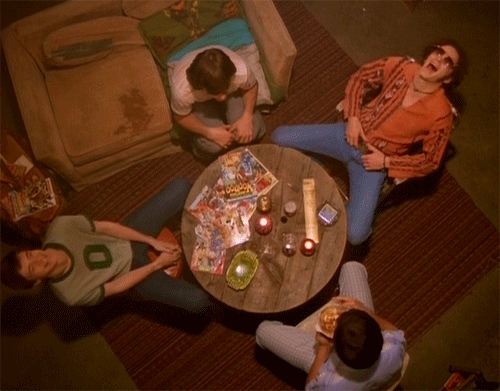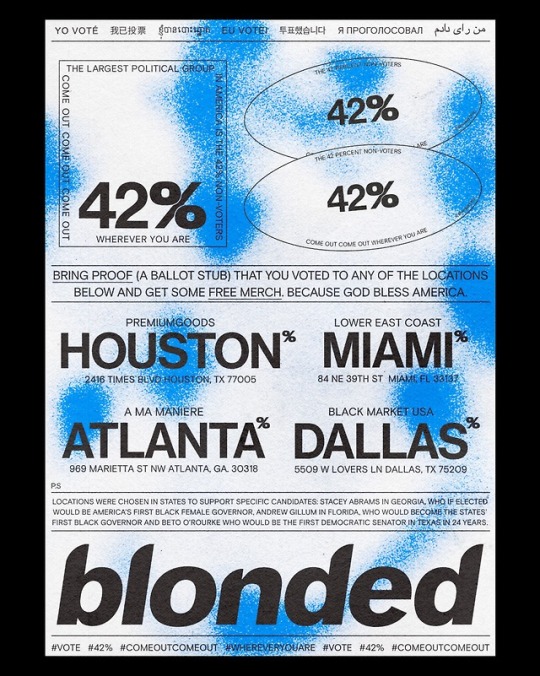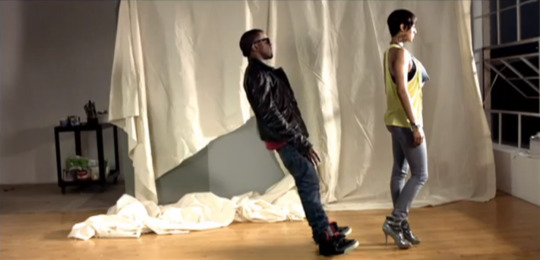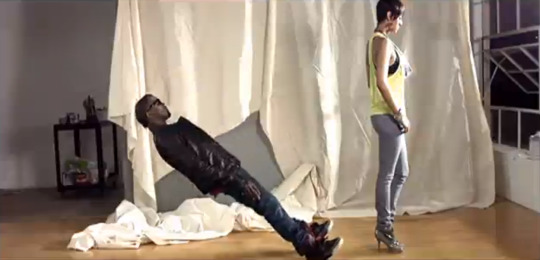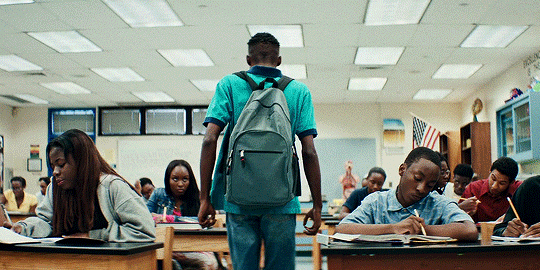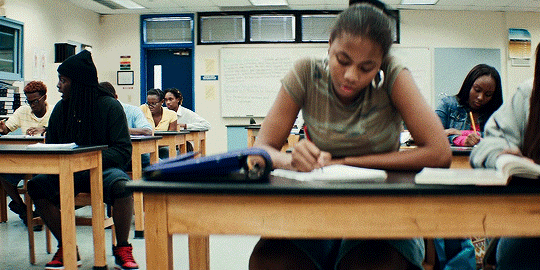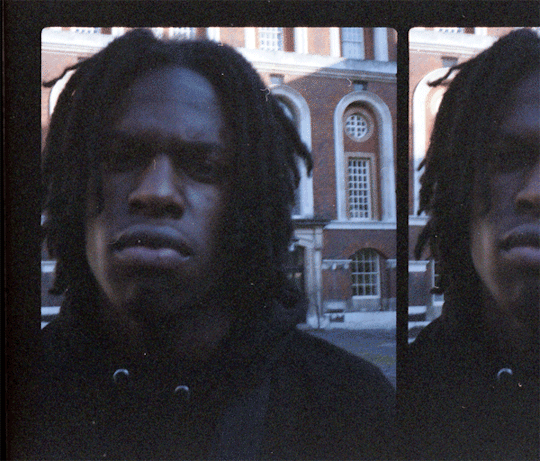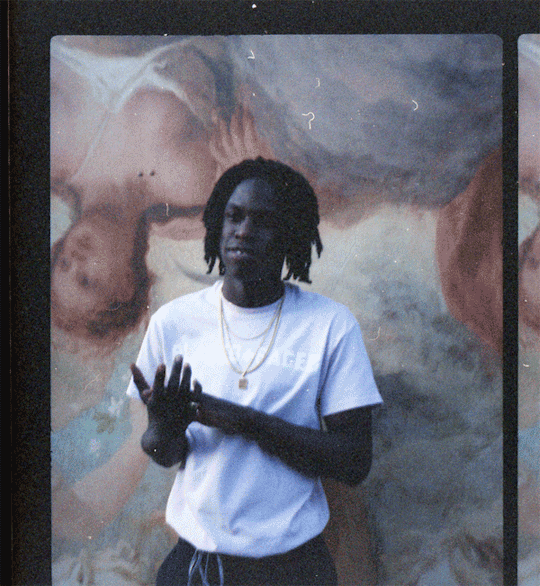Don't wanna be here? Send us removal request.
Photo
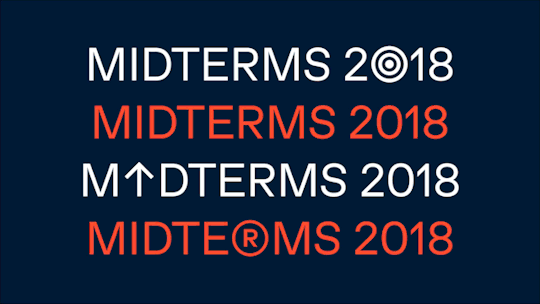
Happy Election Day, Tumblr!
If you’ve already mailed in your absentee ballot or participated in early voting, give yourself a pat on the back followed by a healthy round of applause. You did it, constituents! You knew your voice was important and you made damn sure that it was heard.
For the majority of you, today is your time to shine. These midterm elections are important because you get to vote at the local level. You get to have a say in what matters the most to the communities in which you live, work, and spend much of your time and money.
Today is your chance to protect what you love and fight for what you believe in.
Make sure you’re prepared before you leave your home to vote:
Make sure you have any necessary paperwork If you live in New York or California, you can just state your name and address to cast your ballot. Neat! Other states have different requirements, like you may need to present a photo ID. You can check out the specifics for your state here.
Look into when and where to vote Some voting polls can open as early as 6 a.m. and close as early as 6 p.m. Others are open until 9 p.m. Checking your polling location and its hours is easy—just head on over to Vote.org’s polling place locator.
Know your rights It’s important for you to know your rights and what actions you can take if you are denied the opportunity to vote. Voter intimidation is illegal, and you have every right to report any sort of intimidation or harassment you see at the polls. This can affect anyone, but is often used to prevent historically disenfranchised people from being heard.
Voting is a right. Voting is a privilege. Voting is a responsibility. When you vote today, think of the people in your life who weren’t able to vote 60, 80, 100 years ago. Think of how far we’ve come. Think of how far we still have to go. Think of the voiceless who are not able to vote today, but deserve as much help and protection as anyone else. Just think—and vote.
Oh, and join us later tonight for live coverage of the midterms with Yahoo! News. Just hop on Tumblr at 7:30 p.m. ET and you won’t miss a beat.
This is it. See you at the polls, Tumblr.
7K notes
·
View notes
Text
Into the Twittersphere
As society continues to usher into and embrace the cyber and digital age that has come to define the past decade, it is no surprise that social media dominates not only our mobile and handheld devices, but also the real world political landscape. My respective generation of millennials and post-millennials has grown up with and transitioned from MySpace to Facebook to Tumblr to Twitter to Instagram to Snapchat and all of which amongst many other platforms have raised the scale, brought upon new ways of expression and posting, and influenced significant events and current reality. Out of all these forms of social media, Twitter has probably evolved the most in terms of how users first used the site and application versus how they use it today. As an avid iPhone user and social media connoisseur, I have plenty of experience with Twitter and the aforementioned apps to which I gained throughout my adolescence. Given that I joined Twitter in 2012, I have witnessed several shifts in the blue bird’s dynamic as content is constantly changing and being generated. In this following piece, I will examine the Twitter of the past and the Twitter of now and look in between the years of how it has impacted consumption of entertainment, news, and politics, and overall, society and the world.
Before diving into the evolution of Twitter, it is especially important to look at its origins and popularization. Amanda MacArthur details the history of Twitter in her article “The Real History of Twitter, In Brief”, in which she recounts how the social media site first began as a side project for co-founder Jack Dorsey in the year 2006 (MacArthur 1). Dorsey even intended for Twitter, or “twttr” (what it was commonly referred to in its early days), to be an SMS-based communications platform, so basically a different way of texting friends (MacArthur 1). The concept indeed started off as such until the idea then developed and branched out into a social network as several users hopped aboard the Twitter train, or bird for that matter. As Twitter experienced this explosive growth, it was interesting for the programming team to see how much people were producing with a 140 character limit (now 280 characters). What once started as a vision for a new method of messaging progressed into a user base of millions and an innovation of replies, mentions, @ symbols, retweets, and the famous hashtags. Twitter became its own social media network site, or SNS, and fits all the characteristics that Danah M. Boyd described in “Social Network Sites: Definition, History, and Scholarship”. Boyd defines the term SNS as a “web-based service that allows individuals to (1) construct a public or semi-public profile within a bounded system, (2) articulate a list of other users with whom they share a connection, and (3) view and traverse their list of connections and those made by others within the system” (Boyd 211). That certainly sounds like Twitter as the site progresses even further in developing along with its user base and audience.
Based on my personal experience of using Twitter ever since 2012, I have kept up with and followed content that has made me laugh, made me smile, made me sad, made me astonished, and made me angry. Through this spectrum of Twitter consisting of so many users of different social and ethical backgrounds, it is arguably poetic that the platform brings people together just as much as it tears people apart. For instance, in “The Power and Political Economy of Social Media”, Christian Fuchs claims a limit on social media in respect to its participation as an ideology. Fuchs argues against social media as participatory as he feels that people are using media to form opinions on entertainment based topics instead of political topics to which he finds more important (Fuchs 98). In many cases Fuch’s statements holds true throughout Twitter’s existence, but I do believe the site has raised more political concerns in the past two years. Yes, Fuchs even specifies the limits of Twitter in regard to how “Obama has a very large number of followers [while] the number is much lower for representatives of alternative politics” (Fuchs 102), but it is imperative to note that despite only being written in 2014, the political landscape has changed so much in heavy part to Donald Trump. Exclude Trump’s presidency and love for tweeting, and there are still many others cases and situations in which Twitter has went beyond talking about the hottest celebrity scandals and stories and instead more about world politics and national crises and issues. Unlike other SNS counterparts such as Facebook, Twitter tends to not get soaked with the whole idea of iCapitalism, or commodification of information, a concept described by Alistair Duff in “Rating the revolution: Silicon Valley in Normative Perspective”. I strongly believe that the Twittersphere primarily revolves around information being produced and shared for that simple matter as it reflects the information society established by Silicon Valley (Duff 1609). However, with all this content and with every popular trend and network of countless users, there exists both goods and bads.
I stand by the perspective to which Twitter has changed the world, but the platform essentially has changed lives for not just the better, but also for the worst. In her article for The Guardian, Elena Cresci reviews ways in which Twitter has extended its influence to its user base beyond the 140/280 characters. Cresci highlights how the social network media site has helped, but also hurt businesses, changed the way we consume news, but what also makes news, made stars out of politicians and important figures but also out of random teenagers and animals, and brought about the rise of hashtag activism that has widely influenced campaigns and movements (Cresci 1). Many of these negative points draw back to Fuch’s claim that social media is only concerned with entertainment, but how can you blame the user base for expressing what they want to see and generate? To help elaborate, in “Active Audiences and the Construction of Meaning”, David Crouteau and William Hoynes discuss roles of the active audience and how they interpret media. This relates to Twitter users in the sense that they are similar to active audiences that engage in media socially (Crouteau and Hoynes 263) and for the simple fact that media is pleasurable and entertaining (Crouteau and Hoynes 287). They also briefly mention how audiences directly share similarities and differences to “users” as traditional media has transitioned into new forms of media (Crouteau and Hoynes 292). Altogether, this shows that those active in the Twitterverse are partaking on the platform on their own regard. The positives generally outweigh the negatives as the modern sphere of Twitter continues to speak on real issues and advocate for change in a world with lingering problems whilst maintaining a sanctuary for memes and popular culture.
Overall, Twitter has unleashed a wave of users that continue to express an ideology that grabs the attention of other users and puts them in this cycle of tweeting towards and against a dynamic and landscape of entertainment and politics. In that regard, it leaves me to wonder what Twitter will evolve and progress into next while society and mass media proceed to intertwine. After all, the Twittersphere was only intended to be another texting service just a little over a decade ago.
Media Art Complement

The following collage I photographed and put together represents how Twitter is capable of creating viral sensations and stars. Pictured below is Joshua Malilay, a close friend of mine, who has a passion and incredible talent for music. In the summer of 2016, he tweeted a song cover video of “I Want To Be Your Lady” by INOJ. Given that the song was so popular at the time amongst Twitter and other social media users and because of how gifted Josh’s voice is, his tweet blew up, he gained hundreds of followers, and he instantly became - as many would say - Twitter famous. This example of my good friend exploding onto the scene demonstrates the constant interest in entertainment of Twitter, how it has evolved since its conception, and significantly how this SNS and media form can positively impact its users as Josh has garnered much attention while he looks to pursue music. (35mm film photography and Twitter screenshot courtesy of Martin Mamangun, 2018)
References
Boyd, D.M. “Social Network Sites: Definition, History, and Scholarship.” Journal of Computer-Mediated Communication 13, no. 1 (2007): 210-230. http://onlinelibrary.wiley.com/doi/10.1111/j.1083-6101.2007.00393.x/epdf
Cresci, Elena. “12 Ways Twitter Changed Our Lives.” The Guardian, Guardian News and Media, 21 Mar. 2016, www.theguardian.com/technology/2016/mar/21/12-ways-twitter-changed-our-lives-10th-birthday.
Crouteau, David, and William Hoynes. “Active Audiences and the Construction of Meaning.” In Media/Society: Industries, Images, and Audiences. 5th ed. Thousand Oaks, CA: Sage Publications, 2014. Pp. 260 - 293.
Duff, Alistair S. “Rating the revolution: Silicon Valley in Normative Perspective.” Information, Communication & Society 19, no. 11 (2016): 1605-1621.
Fuchs, Christian. “The Power and Political Economy of Social Media.” In Social Media: A Critical Introduction. London: Sage Publications, 2014. Pp. 97-122.
MacArthur, Amanda. “The History of Twitter You Didn't Know.” Lifewire, Lifewire, 28 April 2018, www.lifewire.com/history-of-twitter-3288854.
2 notes
·
View notes
Text
SPENDING TIME
SPINNING OUT TOWARD
A DESIRE THAT WASN’T PURE
BORN BEFORE THE VIRUS WAS CURED
PITCH PERFECT
VIOLINS ON THE FLOOR
FAST FORWARD LININGS ON MY SKULL
TYPE OF DESIGN I COULD AFFORD
FAST FORWARD BANDS OUT
GOT THEY HANDS OUT
LIKE THEY’RE ACKNOWLEDGING THE FÜHRER
REWIND NAS TRACK 6
REWIND DANCE CRAZES
READ MY MIND
FREED MY MIND
FEED MY MIND
MAKES SENSE
JUST LIKE MIRRORS ON THE WALL
JUST LIKE SITTING ON ME
RAW IN MIRRORS SEEN IT ALL
COULD MAKE TWO
A PIECE OF MIND
FLICKING ASH
POURING A HALF
DONT POUR IN A GLASS
POUR IT IN FOAM
THAT’S WHITE LIKE EGGSHELLS IN MY OMELETTE
MY EARLOBES ARE YELLOW LIKE THE YOLK IS RUNNING
MY BRAINS ON DRUGS
I STILL HAVE NO PEACE OF MIND
FUCK
WOOF WOOF DOGS IN THE PLACE
LOOSE TOOTH LOST IN THE FRAY
ROOF LOST IN THE WRAITH
ROOF LOST ON THE WAY
FREEWAY
NO ROZAY
BRUTE FORCE
BRUT CHAMPAGNE
TELL THE FRONT DESK TO CUT NEW KEYS
RESERVED IN THE MERCER FOR TWO YEARS
IN TWO SUITES
TOOK OUT THE BED LIKE ITS FUCK SLEEP
ILL SMACK A BITCH LIKE ITS HOT HANDS
FIRED THE LABEL LIKE FUCK BRANDS
COMFORTABLE LOW NIGGA FUCK XANS
COMFORTABLE SLOW WHO THE FUCK RAN
NOTHING IS SWEET
NOTHING IN TANK SWEET
ITS JUST A TANK P
SALT ON A SLUG
SODA ON SLUGGED TEETH
CHEWING ON NOTHING
UR TWEAKING OR SOMETHING
UR SPEAKING SPEAK UP THEN
UR THINKING UR OVERTHINKING
ONE BLINK AND IM PRECUMMING
THAT COULD TURN EVERY NO ONE
INTO SOMEONE
27K notes
·
View notes
Photo


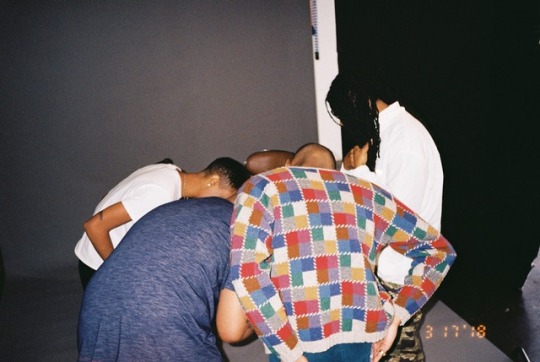



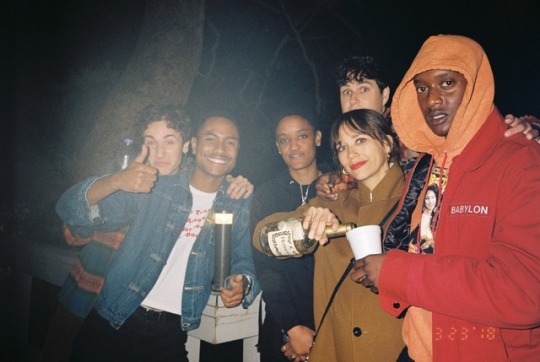
always up to something. photos by alan lear
977 notes
·
View notes
Photo







In Search of Rainbows by Anna Carey
“Los Angeles based, Australian artist Anna Carey presents her latest body of photographs documenting miniature fictional architectural spaces…”
146K notes
·
View notes
Text
“Well I️ made the album before 30. I️ JUST AINT PUT THAT BITCH OUT!” -quotes from an interview I️ haven’t given haha
24K notes
·
View notes
Photo

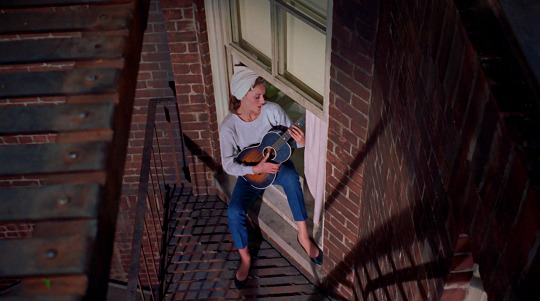
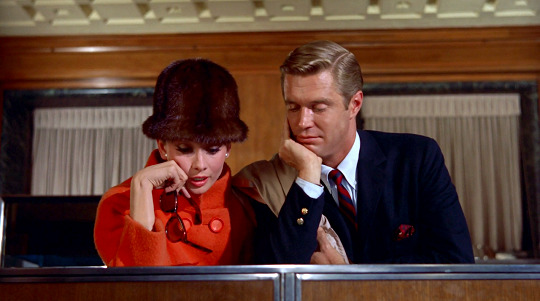


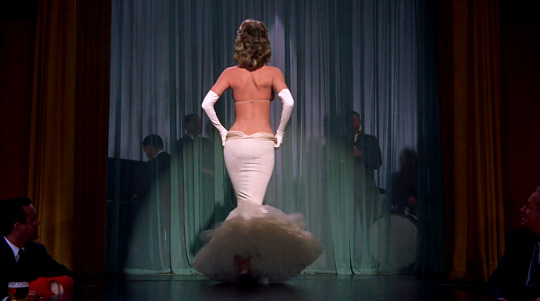



There was once a very lovely, very frightened girl. She Lived alone except for a nameless cat.
Breakfast at Tiffany’s (1961) // dir. Blake Edwards
4K notes
·
View notes
Text
What is Yours
What drives us? What drives us to do this certain thing or to act this specific way or to say this particular word? What exactly is that positive motivating force within our lives? One person says that drive and force is free will while the next person refutes instead claiming it is fate. The free will and fate debate is one such dispute that has been heavily argued for many centuries and remains a complicated mystery to several. Free will as defined by dictionary.com is “the ability to choose, think, and act voluntarily” (Dictionary.com). To elaborate, we as human beings control our very own actions. On the other hand, fate is defined as “the universal principle by which the order of things is presumably prescribed” (Dictionary.com), which is essentially saying that those same human actions are all really inevitable and predetermined by some outside power or force. As free will rejects the notion of fate, fate is synonymous with the common phrase “everything happens for a reason”. What if neither free will or fate solely dictated our lives, and instead the truth could be found in that which “lies” to us in the form of hegemony. And through this hegemony, our ideologies and public spheres are framed in such a manner that shifts our mind to think that we are in control of our lives when in reality, we are not.
Antonio Gramsci describes the concept of hegemony in his work, “Hegemony, Intellectuals, and the State”. Gramsci understands hegemony as the spontaneous consent that is bestowed upon intellectuals by the mass because of their historical significance of position and and prestige within society (Gramsci 75). He further suggests that it entails state coercive power, which legally enforces consent upon society (Gramsci 75). To break this down in more simple terms, hegemony is how we consent subconsciously and conform to that of which is deemed the norm. So how exactly does this idea of hegemony relate to the whole free will versus fate debate? To answer this question, I propose another question: is it really free will of one person to do something another person is doing just because that said thing is the norm? Given the definition of the term, then yes, it is indeed free will. But, beneath that underlying surface, the answer is arguably a no. You are acting for yourself, but not in your own individual interests, but in the interests of a popular consensus. To put this all into perspective, let’s take another examination of hegemony. Hegemony works to educate people based on the values of the dominant, but this dominant influence, however, is collective rather than free and personal. Thus, I can go on to say that free will and the sense of conformity that arises from hegemony are not related to each other in our everyday processes. Fate does and does not play into this equation. For instance, fate cannot be always be viewed in the context of religion in which outside powers guide your actions and occurrences. The logical explanation is that hegemony itself takes on the “universal principle” for people and not necessarily predetermines events, but allows us to act in hope of gaining the best possible outcome. Again this expected positive outcome is based on what the consensus has normalized. To piece this information all together and summarize it all up, free will exists to some degree, but that degree depends upon the accepted norm determined by hegemony.
In Jim and Andy, a documentary featuring Jim Carrey, legendary actor and comedian, an interesting scenario is given. Carrey states that he picks up a cup of tea because he is thirsty. He then asks the audience as to whether it is free will to pick up the tea or if it is simply the fact that he is thirsty is what makes him pick it up. “What told me to pick up the tea?”, Carrey further asks. This scene drew me into addressing these certain concepts and I found the answer to this head scratcher to be hegemony. In this particular example, the dominating value is thirst and the subconscious consent we give is fulfilling and meeting the needs of that thirst. Furthermore, although hegemony carries this sort of negative connotation, it can function to positively support ourselves.
Let us take a look at ideology and how it factors into the grand scheme of our consent and “decision making”. In “Ideology”, Raymond Williams distinguishes the concept of ideology as (1) a system of beliefs characteristic of a particular class or group, (2) a system of illusory ideas - false ideas or false consciousness, and (3) the general process of the production of meanings and ideas (Williams 55). In whatever way or combination of ways to view ideology, it always takes into account its relation to society and how it functions as a social process. Williams goes on to discuss how it is entirely reasonable to deprive ideology of its “semblance of independence” (Williams 59). Ironically, our own consciousness and ideas that emerge are always part of the material social process that ideology entails. And so, our ideologies function and operate as instruments of hegemony and demonstrate a basis for real life. In reference to the cup of tea, the ideology revolves around the practical sense of quenching your thirst to survive.
Consider the concepts that were explained and the claims that were made. Where exactly does this all fit in for everyone to understand? The answer - the public sphere. In “The Public Sphere”, Jurgen Habermas defines the public sphere as an area in social life where people can discuss and establish change (Habermas 75). The public sphere must also be accessible to all citizens and should ideally exist to allow for democratic expression and the formation of public opinion (Habermas 75). Thus, as a result, the public sphere can enable public control of “state activities” (Habermas 77). This realm outwardly includes everyone, but are we are all really engaged? For example, the liberal model of the public sphere is still instructive today, but it cannot be applied to other conditions (Habermas 78) and in this age of media and technology, not everyone can participate. And for those that do participate, in regard to hegemony, the public sphere distracts them in the form of media and culture and in a way that conforms them to the public opinion that is in fact the norm.
Hegemony arguably manipulates our ideologies and uses the public sphere to enforce exactly what Gramsci suggests it entails - consent and conformity. We are made to think that we are applying some sense of free will and control, but in reality, we are subconsciously consenting and conforming to societal norms. This is not necessarily a negative thing for hegemony can be applied to better the members of society in ways that are obviously practical and essential to life. But, how far can practicalities take us if everyone is trying to be the same. There must exist taking risk and countering hegemony for us to really act in our own regard. If not, then a person’s individuality is undervalued because a whole consensus is perceived as more valuable in the face of society. And if beneath the surface, there is no free will in that respect, then what exactly makes human beings different from the artificial “human” robots we are beginning to see on the news and online. Besides the obvious biology between the two entities, both human and robot are controlled and socialized to give consent in the main interests of others and not for themselves. Additionally, we are so caught up in and dictated by everything that media puts out. Overall, society is complex in this manner of control and conformity. If everyone was conditioned and taught that acting in our own desires is more good than bad, then that would support the notion of free will and there would be really simple answer as to what drives and motivates a person.
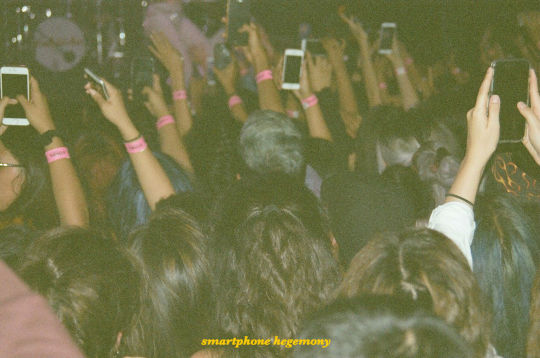
During a concert, the majority of the audience takes out their smartphones almost in unison demonstrating hegemony in action. We easily consent to media even at the tips of our fingers and are heavily influenced by the growing wave of technology. (Photo courtesy of Martin Mamangun, Sept. 2017)

As city dwellers we have access to public transportation, but not everyone can get to them so easily. In that regard, as members of society we have access to the public sphere, but not everyone is engaged in it at this day and age. (Photo courtesy of Martin Mamangun, Dec. 2017)

The aspects of society that we consent to can create this false semblance of independence and free will because we are really actively participating in a sense of conformity. Similar to the mass of people crossing the street as pictured above, we are just following what is in front of us. (Photo courtesy of Martin Mamangun, Sept. 2017)
References
“Dictionary.com.” Dictionary.com, Dictionary.com, www.dictionary.com/.
Gramsci Antonio. “Hegemony, Intellectuals and the State,” in Cultural Theory and Popular Culture: A Reader, ed. John Storey, pp. 75-80. New York: Routledge, 1994[2013].
Habermas Jürgen. “The Public Sphere,” in Media and Cultural Studies: KeyWorks, 2nd ed., eds. Meenakashi Gigi Durham and Douglas M. Kellner, pp. 75-79. Malden, MA: Blackwell 2012
Williams, Raymond. “Ideology,” in Marxism and Literature, pp. 55-71. New York: Oxford University Press, 1977.
0 notes
